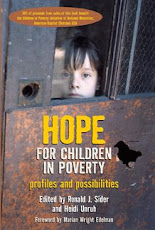"It is virtually impossible to reclaim the life of a child who has spent his childhood without a home."
I don't know if that is true. In fact, there are ministries all around the country investing in homeless children and their families precisely because they take it as a matter of faith that reclaiming these lives is not only possible but mandated. Or perhaps, if this is really is an impossible task, that we are called to work miracles.
If so, the demand for miracles is growing. According to America’s Youngest Outcasts: State Report Card on Child Homelessness, a report from the National Center on Family Homelessness (NCFH), more than 1.5 million children become homeless each year. This means that one out of every 50 children and their families have gone to sleep in a shelter, a car, an abandoned building, or on the streets.
The executive summary describes the implications of this statistic:
These children also endure a lack of safety, comfort, privacy, reassuring routines, adequate health care, uninterrupted schooling, sustaining relationships, and a sense of community. These factors combine to create a life-altering experience that inflicts profound and lasting scars.
Children without homes are twice as likely to experience hunger as other children. Two-thirds worry they won’t have enough to eat. More than one-third of homeless children report being forced to skip meals. Homelessness makes children sick. Children who experience homelessness are more than twice as likely as middle class children to have moderate to severe acute and chronic health problems. Homeless children are twice as likely as other children to repeat a grade in school, to be expelled or suspended, or to drop out of high school. At the end of high school, few homeless students are proficient in reading and math – and their estimated graduation rate is below 25%.
Child homelessness has been relatively concentrated – with 11 states contributing three-quarters of all homeless children. (Find out how your state ranks on the interactive map at http://www.homelesschildrenamerica.org.) With the rash of foreclosures and general economic downturn, homelessness is expected to grow both more prevalent and more widespread. (How many foreclosures have there been in your state since the start of this year? Find out at the Center for Responsible Lending website.)
"If we fail to act," the report concludes, "the consequences will play out for years to come as a generation of lost children grow to adulthood." Yet the report also affirms that action is possible, even in these harsh economic times. It provides a list of measures that federal, state and local governments can take toward the goal of ending child homelessness within a decade.
More:
* Visit the "America's Youngest Outcasts" website and download the report here
* Read about Colfax Community Network, a ministry with children in precarious housing profiled in Hope for Children in Poverty, here
Thursday, April 16, 2009
Subscribe to:
Post Comments (Atom)

No comments:
Post a Comment